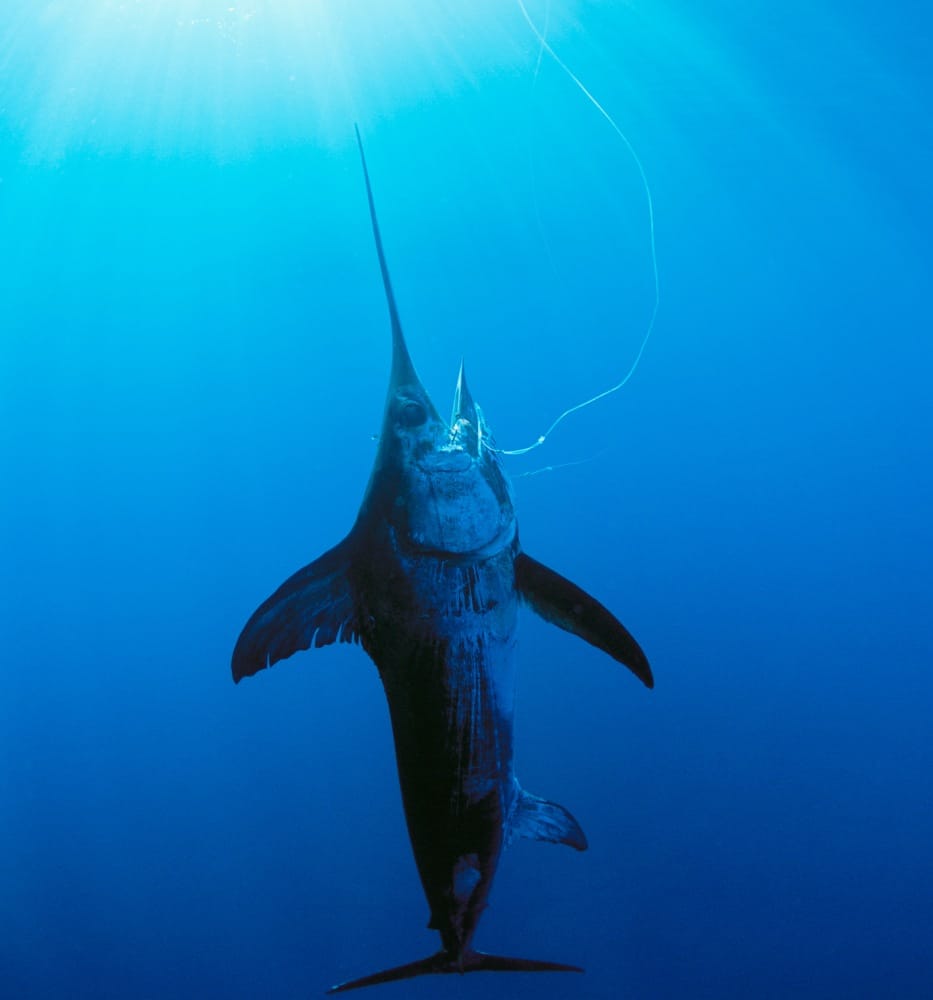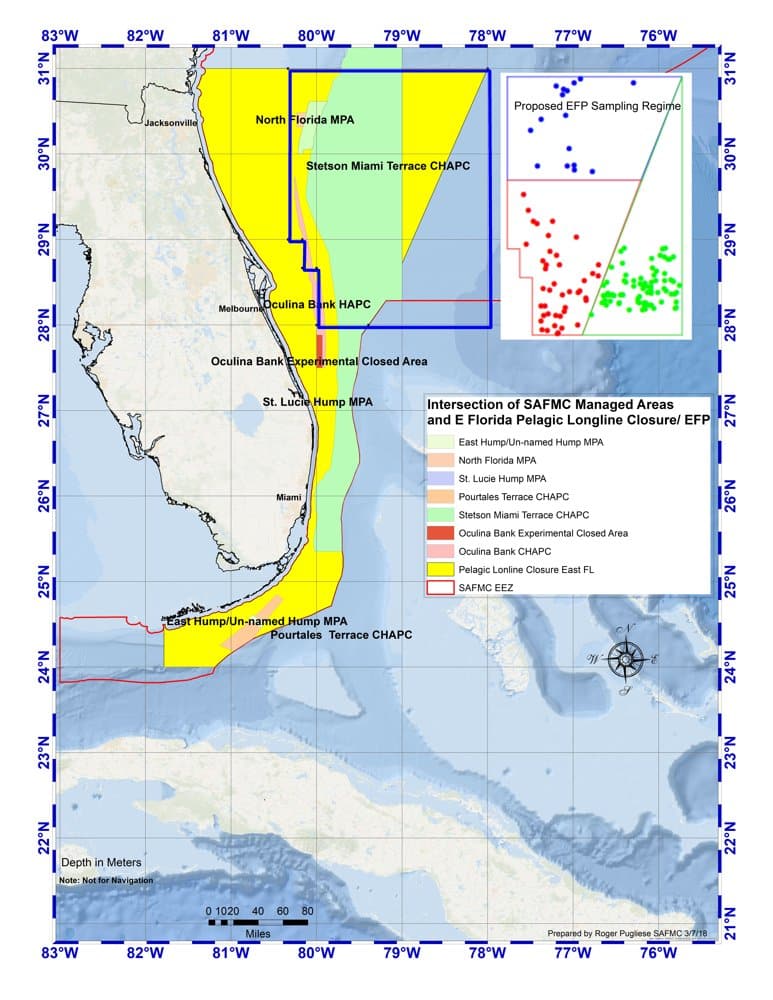
If you are a fan of schemes to privatize public resources for the benefit of a very few and to the detriment of the American public, a plan currently being evaluated by the Highly Migratory Species Division (HMS) of the National Marine Fishery Service (NMFS) will warm your heart.
The application submitted by David Kerstetter and Day Boat Seafood, LLC is for an exempted fishing permit (EFP) to allow longlining in an area off Florida that has been closed to that activity since 2001.
EFPs are granted pursuant to the Magnuson-Stevens Fishery Conservation and Management Act and allow research to be conducted at times and places where fishing or the collection of samples might not be allowed otherwise. These permits – for the most part – enable valid research. However, in recent years, the process has been abused by those who wish to profit from rather than conduct true research. Recent efforts to establish catch share programs started with EFPs like this one.
In the 1980s and 1990s, swordfish were in trouble in the U.S. The number of fish and the average landed weight for these fish had gone down. It was determined that a major cause of the problem was that too many juvenile swordfish were being killed by longlining activities. Several organizations had already sued NMFS, and there was talk of an Endangered Species Act listing. The federal government designated two areas off the East Coast that would be closed to longlining: one area off the Florida coast and the other off South Carolina, known as the Charleston Bump. In 2001, NMFS closed these areas to longlining. The effort was almost immediately effective and by 2007, swordfish were declared recovered. Ever since that time, there have been efforts to reintroduce longlining in these proven nursery grounds and designated conservation areas. Kerstetter has been involved with four of these attempts and the co-applicant, Day Boat Seafood (Day Boat) has been involved in three.
On the third attempt by Kerstetter, the permit was granted. However, Nova Southeastern University was listed as the associated institution. When leadership of Nova Southeastern found out about this, they demanded that Kerstetter take the University’s name off the permit. As a result, NMFS withdrew the permit.
In response, Kerstetter formed an LLC, Florida Fisheries Solutions, late last year, then re-submitted the EFP application with his shiny, new LLC as its sponsor. This entity is not, by any stretch of the imagination, a sponsoring institution. Florida Fisheries Solutions consists of one member, one manager, Mr. Kerstetter, and the principal place of business is his home.
There is a recognized need to monitor Marine Protected Areas (MPAs) and closed areas to determine whether the management objectives which caused these areas to be “protected” are being met. Obviously, these monitoring efforts must have as little adverse impact on the protected area as possible.
As a result of previous consultations, NMFS determined that four longline sets per quarter for three years in the three proposed study areas would be sufficient. Thus, the total number of sets required for statistical validity would be 48 per year for a total of three years resulting in 144 sets. The current Kerstetter application calls for 1,080 sets per year for a total of 3,240 over the three-year study period. This is more than 22 times the amount of effort that would be required statistically. Certainly, there is no effort in this application to minimize adverse impacts.
This application is not science. Rather, it is commercial fishing.

To sweeten the pot, Day Boat would be the only entity with the right to longline in this conservation area. They alone would be given the right to make 3,240 longline sets in a protected area, with 2,160 of these sets in the nursery area. Interestingly, the permit would give Kerstetter and Day Boat the right to sell the ability to fish to non-Day Boat longliners in these two closed areas if the non-Day Boat longliners contribute “funding support” to Kerstetter. Day Boat and Kerstetter would be given the right to negotiate the amount of this “funding support.”
This EFP represents the first step to not just a catch share, but catch shares on steroids. One company would be allowed to rape and pillage in protected areas and keep and sell anything it “legally” catches. This same company would be given the ability to lease this right to others just as the Snapper Barons in the Gulf of Mexico now lease shares of Red Snapper quota. At least in the Gulf, there is some limitation on the number of shares one individual can own. Here, all the shares would be given to one entity.
Staffers at HMS must have foreseen the unpopularity of this latest EFP. They decided to forgo transparency and omit a formal public comment period. However, HMS did ask that the South Atlantic Fishery Management Council (SAFMC) look at the pending proposal. The Kerstetter plan was therefore placed on the agenda for discussion at the SAFMC’s March meeting. The SAFMC allows public comment on pretty much any topic. The Council received 654 comments against this EFP application. There were no comments in favor. Many fishery organizations have condemned this plan as has the State of Florida. The only known organization to speak in favor of the plan, as you might guess, is the Environmental Defense Fund (EDF). EDF has never seen a catch share scheme it did not like, no matter how ridiculous.
The International Commission for the Conservation of Atlantic Tunas (ICCAT), the international body which regulates swordfish quota amongst the different nations, considers the recovery of western swordfish to be its greatest victory for conservation. It is beyond comprehension that NMFS would put at risk one of the greatest conservation victories of all time. It should be remembered it is not just the juvenile swordfish that are being placed at risk with this EFP but also the nation’s best sailfish fishery due to the bycatch mortality of sailfish.
While NMFS failed to offer a formal comment period that does not mean you should hide your outrage. Contact Acting HMS Director Randy Blankinship at randy.blankinship@noaa.gov.
About the Author:
Chester Brewer served 10 years on the advisory panel of ICCAT which manages tunas, swordfish and billfishes, among other species. He is currently in his second term as a member of the South Atlantic Fishery Management Council. The opinions expressed herein are those of Chester Brewer and not necessarily of the SAFMC.
Sport Fishing welcomes opportunities to share a variety of perspectives from prominent or influential participants in issues related to recreational fishing and fisheries.








